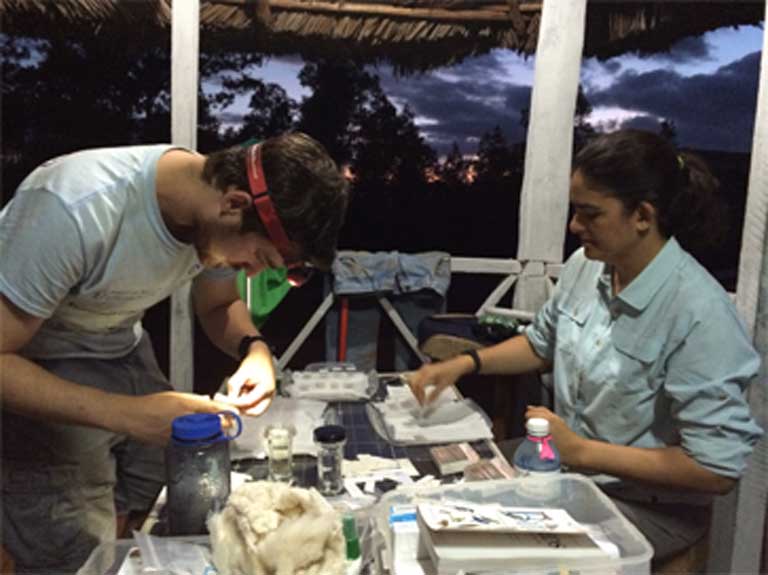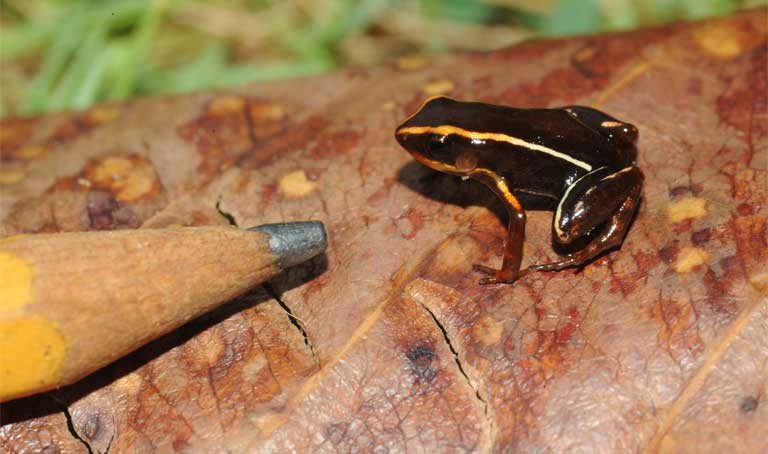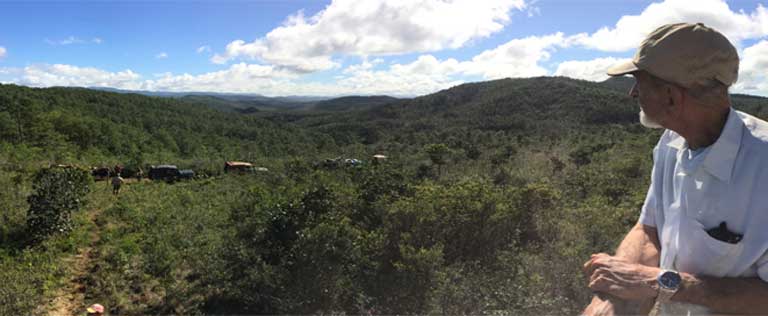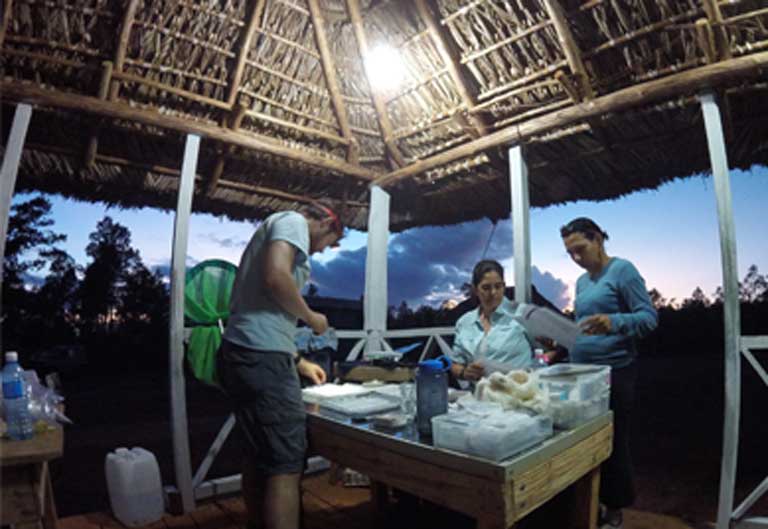- As travel restrictions ease up, US citizens are discovering Cuba, an archipelago less than 150 kilometers (93 miles) from Florida. Biological research is also on the upswing, and scientists are working with their Cuban colleagues to assess the rich biodiversity that earned the island its nickname: “Pearl of the Antilles.”
- In 2015, a team of US and Cuban scientists traveled to Alejandro de Humboldt National Park, a UNESCO World Heritage site, as part of Explore21 — an initiative launched by the American Museum of Natural History to apply multidisciplinary approaches and new technology to biological surveys.
- The US and Cuban scientists overcame challenging travel conditions, and once on site, worked around the clock to survey and inventory species –– many unique to Cuba. One of every two plants are endemic, while for amphibians, perhaps 95 percent are endemic. The chance of finding new species is high.
- A search for Cuba’s Ivory-billed woodpecker, extinct in the US but possibly still in Cuba, yielded no positive results, though that search was far from conclusive. With the expedition complete, Porzecanski and the other researchers are now poring over collected specimens, and will likely discover and describe species previously unknown to science.

A map of Cuba doesn’t give you any feel for what it’s like to traverse the Latin American country. On paper, it’s 1,250 kilometers (780 miles) long, but never more than 190 kilometers (119 miles) wide. In reality, the landscape is full of surprises as it changes from sandy beaches to impenetrable wetlands, and rolling plains to heavily forested mountains. Traveling can be tough.
“People don’t realize how big the main island is,” says Ana Luz Porzecanski, director of the Center for Biodiversity and Conservation at the American Museum of Natural History based in New York City. “Rain and rough roads can make locations much more inaccessible than they appear on a map.”
Those challenges confronted the expedition of scientific discovery that Porzecanski co-led in 2015 to Alejandro de Humboldt National Park, the largest protected area in the Caribbean.
Cuba boasts many endemic species, only found on that Caribbean island, says Porzecanski: “One of every two plants in Cuba are found only there. For amphibians, it’s off the charts, something like 95 percent are endemic to Cuba. So that tells you there’s a high percentage of species that are very unique. Therefore we probably haven’t accounted for them all. We need to keep looking.”

The trip was part of an initiative launched in 2013 by the American Museum of Natural History to bring multidisciplinary teams together and apply emerging 21st century technologies to promote scientific discovery.
Although collaborations with Cuban scientists were possible during the more than half century US trade embargo, the political environment hampered research in this Latin American country. Among other factors, limited access to vehicles, fuel and field equipment, have made it challenging for Cuban scientists to do field expeditions. So, for some Cuban researchers, this expedition was their first opportunity in two decades to work in Humboldt National Park, a UNESCO World Heritage site on the northeastern end of Cuba.
Mongabay: This isn’t the first time the American Museum of Natural History has worked with Cuban scientists. What made this expedition different?
Ana Luz Porzecanski: It’s true, our collaborations there started in the 19th century. The museum was established in 1869, and shortly afterward they started sending scientists out to explore the world. And Cuba, being relatively close, was no exception. Overall there’s been around 30 field projects over the years –– ranging from work on spiders and crocodiles to geology and paleontology. The amazing thing is that this discovery continues today.
This particular effort was the first joint major Cuban-American expedition to Humboldt Park in many decades, and led with the Cuban National Museum of Natural History.
Our expedition goal was to take a multidisciplinary group to survey and inventory vertebrates and invertebrates across the Park.

It took two days to get our team of scientists, park staff and research assistants from the capital city of Havana at the west end of the island to the city of Guantanamo — about 600 miles to the east. There’s only one road, which starts out as a multi-lane highway but becomes a two-lane road filled with everything from old cars to horse-drawn carriages. Very slow. Then we packed into Russian jeeps — and a tractor — to get up the mountain. Once there, we stayed in tents within thatch-roof huts. Cooking went on all day long so the scientists could work around the clock.
My colleagues estimate they collected at least a half dozen new species of snails, and a similar amount of insects and arachnids, during this trip –– all found within a few short weeks.
We did this in 2015, and we are still looking at what we found. We are certain our work will produce new species for science; invertebrates for sure, and we have other interesting material we are studying. There might be even more unprecedented types of discoveries.

Mongabay: What happens when a new species is discovered?
Ana Luz Porzecanski: It needs to be compared to other similar species currently known. This involves comparing the specimens morphologically and sometimes also in terms of their DNA. For many species, behavior is also an important source of information — this could be songs in birds, or web architecture in spiders.
That is when museum collections of both specimens and genetic materials become essential: by studying a new individual in the context of a collection we can compare it to multiple, sometimes all, known species of a group at once. And because collections usually have series of individuals, we can tell what is simply part of normal individual variation from what is a true species-level difference. Finally, collections increasingly also hold tissue samples of multiple species, which also facilitates comparison.
In the case of a spider collected in Cuba [on our trip], curator Giraldo Alayón of the National Museum of Natural History in Cuba, is doing this comparative analysis right now, in Cuba. So far, we know this spider is from the genus Ohvida, family Ctenidae. This genus is found only in Cuba and the Bahamas.
Once Dr. Alayón determines whether this spider is something new, he’ll write a paper formally naming it and introducing it to the scientific community. With the peer-review and publication process, this can take from six months to a couple of years.
Mongabay: How will this expedition advance conservation in Cuba?
Ana Luz Porzecanski: It is step number one, but it’s certainly my hope that it helps conservation in a number of ways.
It helps because we are able to work alongside our colleagues in the [Humboldt] park. So now we have a relationship with the park, the staff, and their leaders, and we have a better understanding of what they need.

Together we have learned more about what is in the park and what shape it’s in –– which bolsters the case for protection of these forests. It’s not just the biodiversity that is important, but also the fact that this is the largest freshwater source for Cuba.
We also reached out to the local community about the scientific and conservation work, which makes sure they understand the goals and importance of the research, and improves the parks’ relationships with the local communities.
Also, Humboldt Park could be the last place where the Cuban Ivory-billed Woodpecker may live. It’s thought to be extinct. We did do some transects looking for it, but there was absolutely no sign of living birds. It’s an important data point, but there are many other mountains that need to be explored in this area, so no one’s declared it extinct yet.
At the museum, we like to make sure that the exploration eventually gets linked with the conservation, which leads to more exploration. It’s a cycle. Sometimes you enter that cycle with a conservation project. Sometimes you enter with an exploration project, like this case.
Who knew Cuba has all these species — found nowhere else — and so many still to be discovered?
For more on the topic:
AMNH Science Cafe: Museum scientists Ana Porzecanski and Angelo Soto-Centeno talk about their expedition to Cuba:
https://www.youtube.com/watch?v=c6KsQRZUe3w
Center for Biodiversity & Conservation:
http://www.amnh.org/our-research/center-for-biodiversity-conservation
The AMNH Explore21 Initiative
http://www.amnh.org/about-the-museum/press-center/amnh-announces-explore21
¡Cuba! exhibit opens in November 2016

